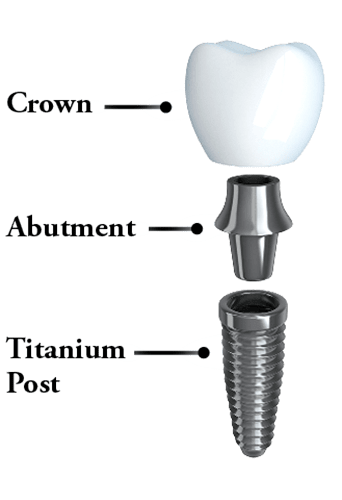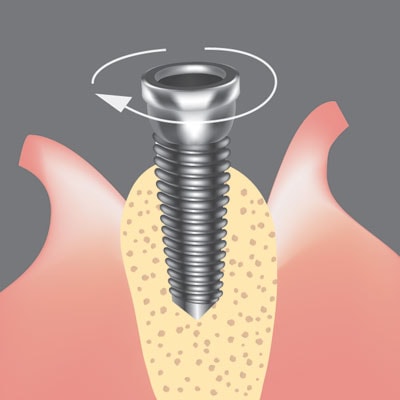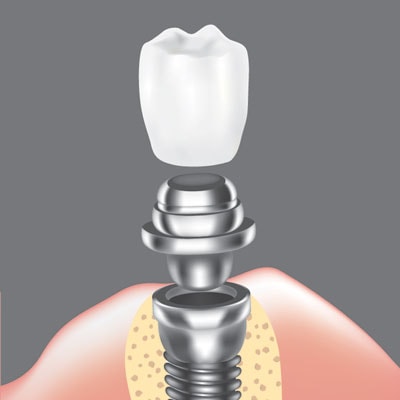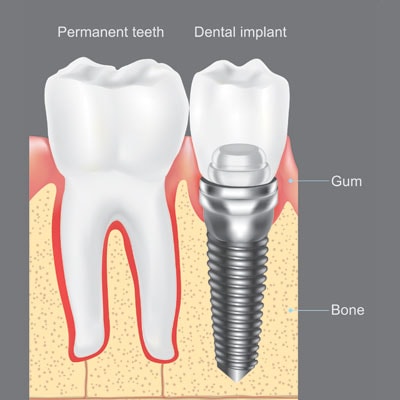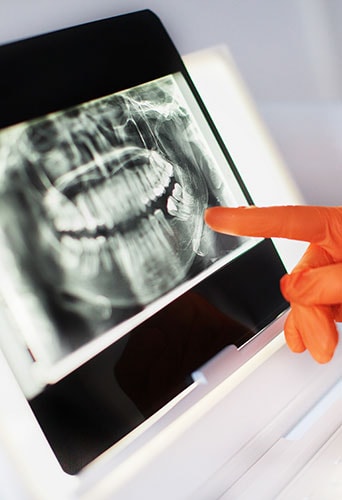Dental Implants
What are Dental Implants?
Generally, people will lose 25% of their supporting jaw bone structure within the first year after tooth loss. Dental implants are more easily placed when teeth are first extracted because bone replacement becomes more complex as time passes. The great news? Implants act similar to your natural teeth. They safeguard and preserve your bone structure, oral health, and appearance. Your dentist and Dr. Lavin will provide you with options so you can make the most informed decision concerning tooth replacement.
Making a team effort
Placing dental implants requires constant communication, and Dr. Lavin will work closely with your restorative dentist to properly place and restore your dental implants, so you walk out of our office with a beautiful smile. Your Sioux Falls periodontist will perform the implant surgery, tooth extraction, and bone grafting (if necessary) while your dentist will make the permanent restorations to place on top of the titanium.
What Can You Expect With a Dental Implant Procedure?
Once you’re comfortable, Dr. Lavin will use special equipment to place the titanium implant into your jawbone gently. He’ll bring great precision and attention to the details of your case to ensure the bone heals properly and fuses with the titanium post.
The amount of time to placing dental implants varies from patient to patient. Normally, it can take 30 to 60 minutes to place one implant and only 2 to 3 hours for multiple implants.
You’ll schedule follow up appointments (one to four appointments) to ensure your mouth is healing correctly. Once healed, Dr. Lavin will place an abutment on the post to make it ready for the restorative phase of your treatment. This allows the gum tissue to mature and provide access to the final phase of the implant.
You’ll finally have a beautiful smile – free from missing teeth!
Replacing Missing Teeth: Understanding Your Options
-
Fixed Bridge
A fixed bridge is a connected set where it’s cemented on the top of the teeth neighboring the empty space. It’ll have the same function of your natural teeth while blending seamlessly with your mouth.
-
Flipper
A temporary and inexpensive solution. This is a removable plastic tooth with a retainer to hide your missing teeth.
-
Metal Partial
This is a removable partial denture cast in metal and plastic, held in place by wire clips. It can be removed and reinserted at your convenience.
-
Dentures
This is a common solution for people with missing teeth. We have full and partial dentures. Needs vary from person to person. Some people adapt well to dentures while others find them uncomfortable.
-
Dental Implants
Implants are the best and permanent solution to replace missing teeth. They create a strong foundation for teeth and keep the jaw healthy and strong. Unlike bridges, surrounding teeth aren’t damaged and it can create a stable foundation for dentures. Schedule a consultation with Dr. Lavin to see if you’re a candidate for implants.
-
Ball Attachment Denture
If you’re missing all of your lower teeth, this implant-retained denture involves placing two implants in your lower jaw and attaching a denture on top of the posts. Your dentures will be stable while you chew and speak. However, you may notice some movement in your denture and sore spots may occur if you get food caught underneath the denture. You’ll still need to schedule periodic appointments for denture adjustment.
-
Bar Attachment Denture
Also known as an “overdenture,” this option involves placing four to six implants, depending on your jaw size or shape, into your lower jaw. After it’s healed, the implants are connected to a support bar to firmly snap the denture into place. It’s more stable than the ball attachment denture with minimal denture movement.
-
Screw-Retained Denture
This option places five or more implants in your jaw and attaching a permanent denture. It’s held in place by screws or clasps that secure it to the support posts or bar. It cannot be removed except at maintenance visits.
-
Individual Implants
This is the best option to closely resemble your natural teeth, which includes placing eight or more implants. The teeth are often joined together for sinus grafting to replace bone height, strength, and support. Since it requires more implant fabrication, this is the most costly option.
-
Implant-Retained Upper Denture
This option allows you to enjoy your foods and gives you a better sense of its temperature. Depending on the number of implants you need, a full denture may not be needed. Either way, your denture will feel more natural and can be removed to clean your support bar and denture.
-
Individual Upper Implants
If you want the best restoration that is similar to your natural teeth and not removable, you’ll probably need 8-10 individual implants (including abutments and crowns) to get this full effect.
Bone Grafting for Dental Implants in Sioux Falls, SD
Dr. Lavin can help you become a dental implant candidate.
With our bone grafting options combined with dental implants, Dr. Lavin can restore your oral and overall health with aesthetic benefits. Dr. Lavin will determine which bone graft materials are right for you.
Bone Grafting Options
-
Types of Bone Graft
- Autogenous Bone Grafts: This autograft takes your bone harvested from the chin, jaw, lower leg bone, hip, or the skull. It’s advantageous because the graft material is live bone, meaning it contains living cellular elements that enhance bone growth.
- Allogenic Bone: This allograft is dead bone harvested from a cadaver, which is processed using a freeze-dry method. Since it’s not live bone, it cannot produce on its own, but it serves as a framework from the surrounding bone to fill the defect or void.
- Xenogenic Bone: This bone graft is from non-living bone of another species, usually a cow. It’s very safe and processed at high temperatures to avoid immune rejection and contamination. It works similar to the allogeneic graft to serve as the framework for bone from the surrounding area to grow.
-
Bone Graft Substitutes
As a substitute, many synthetic materials are available as a safe and proven alternative, including:
- Demineralized Bone Matrix (DBM)/Demineralized Freeze-Dried Bone Allograft (DFDBA): Contains collagen, proteins, and growth factors that are extracted from the allograft bone.
- Graft Composites: Consists of other bone graft materials and growth factors to achieve the benefits of a variety of substances.
- Bone Morphogenetic Proteins: Naturally produced protein to promote and regulate bone formation and healing.
-
Ridge Augmentation
A ridge augmentation is a common procedure that’s often performed following a tooth extraction to help recreate the natural contour of the gums and jaw.
It is accomplished by placing bone graft material in the tooth socket immediately after the tooth is removed. This avoids the need for a second procedure. Then, the gum tissue is placed over the empty socket, which is firmly secured with sutures.
-
Sinus Augmentation
The maxillary sinuses are empty, air-filled spaces located above the upper teeth. When the upper teeth are removed, there is often just a thin wall of bone separating the maxillary sinus and the mouth, making it impossible to place dental implants.
That’s when a sinus augmentation is needed to ensure your dental implants has the quality and quantity of jawbone needed to last a long time. A sinus augmentation can raise the sinus floor and allow for new bone formation. This involves Dr. Lavin making a small incision into the bone and pushing the membrane lining upward while inserting bone grafting material to form new bone. After the healing process, the bone becomes part of your jaw, and Dr. Lavin can place the dental implants and stabilize it in the new sinus bone.
-
Socket Preservation
You may need a tooth extraction because of pain, infection, bone loss, or fracture of the tooth. The bone holding your tooth in place may be severely infected, and the surrounding bone and gums can shrink and recede very quickly after the tooth extraction.
There are many techniques to preserve the bone health and minimize bone loss. We can preserve the tooth socket with bone or a bone substitute. Then, Dr. Lavin covers the bone with gum, artificial membrane, or tissue-stimulating proteins to encourage your body’s natural ability to repair the socket. This will help the tooth socket from shrinking and collapsing, giving you the opportunity to place a dental implant.
Do You Have Questions About Dental Implants?
-
What can I use for teeth while my implants heal?
We can provide many options while tailoring to your needs. If you need a replacement tooth, we can make temporary, removable teeth or a temporary bridge. For those missing all of your teeth, we can make a temporary denture or modify your current denture. Do you want non-removable teeth during the healing phase? Depending on your case, we can place dental implants and “load” them immediately. This means a temporary or permanent replacement tooth can be placed on, or shortly after, the day the implant is placed.
-
Will I feel any pain after the procedure?
Most of our patients report they don’t experience severe or significant post-operative pain. Dr. Mark Lavin will prescribe pain medication and antibiotics to make your recovery as easy as possible.
-
How long will my implants last?
With proper care and visiting your dentist biannually, dental implants usually last a long time. Studies have shown dental implants show a success rate of greater than 95 percent!
-
How much do implants cost?
Dental implants are well worth the investment in your health and overall appearance. Having functional teeth makes it a pleasure to eat a balanced, healthy diet, preserve your facial contours, and allow you to speak clearly. The cost of implants depends on the procedure and how many implants you’re receiving. We do accept CareCredit with up to 18 months of payment. Call us for more details 605-332-6300.

